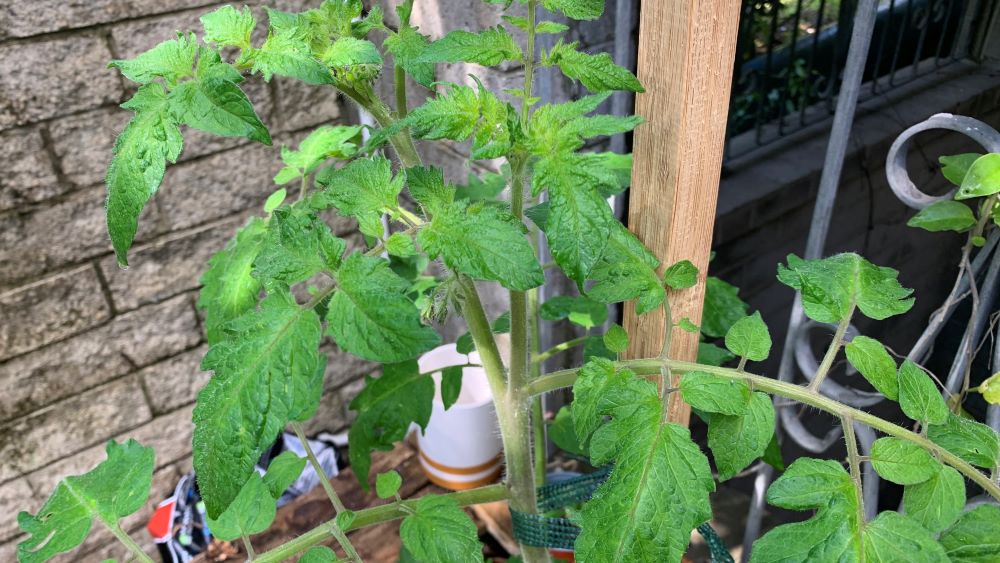If you’re growing tomatoes and notice black edges on the leaves or black spots on the fruit itself, it can be distressing.
There are several causes of black spots on tomato leaves including late blight disease, bacterial canker disease, bacterial speck disease or Septoria leaf spot disease. The good news is that you can save the plant if you catch the problem early enough, so everything is not always lost.
This article will explore the top 4 causes of black edges on tomato plants and have to solve each one.

4 Causes of Black Edges on Tomato Leaves
Tomato leaves can get black edges if they develop a fungal or bacterial infection. Here are some of the more common diseases that cause tomato leaves’ edges to turn black.
1. Late Blight Disease
Late blight causes dark spots on the edges of the tomatoes’ leaves. These spots can spread until they’re almost to the stem of your plant, and it’s also possible to find small dots of white mildew in the same location.
Late blight and early blight are two types of blight disease, but with early blight, you do not get the dark spots on the leaves’ edges.
2. Bacterial Canker Disease
Not only does this disease affect the leaves of the tomato plants, but it also affects the stems and even the fruits themselves. The leaves become discolored and can even turn dry and crispy.
The leaves and stems eventually become black in various areas, while the fruit itself will get white spots. In many cases, the cause of this disease is an infected tomato seed, and it can spread very quickly once it gets started.
3. Bacterial Speck Disease
This disease affects tomato plants all over the world, and it matters not what the environment or temperature is. It starts with small black spots that are most often found on the underside of the leaves.
In more mature plants, you might also notice a yellow ring around the spots, which can either be sunken in or raised. If left untreated, the skin of your tomatoes will also have black spots on them.
4. Septoria Leaf Spot Disease
This is a fungal disease that affects mostly the leaves of your tomato plants. It starts as yellow spots on the leaves of older plants, but those spots eventually turn a dark blackish-brown.
They usually have a light-brown halo around them, and the main cause of this disease is too much moisture, overwatering the plant. The leaves eventually become limp and fall off if the disease isn’t treated.
6 Ways to Prevent Black Leaf Edges on Tomato Plants
While not all fungal and bacterial diseases on tomatoes are preventable, there are still ways you can prevent black edges from forming on the leaves of your tomato plants. Following are a few of those ways:
1. Plant Your Tomatoes Far Apart
Beginning gardeners often make the mistake of planting their tomatoes too close together. The problem with this is that any disease that occurs will spread very quickly. For this and other reasons, it’s good to plant your tomatoes 18–24 inches apart.
This helps stop the disease instead of allowing it to spread to other plants. You should also consider rotating the plants in your garden every year, which will help if the cause of the problem is infected soil.

2. Buy Only Disease-Resistant Seeds
This is a lot easier to do than you think because there are now seeds that are specifically bred to be resistant to certain diseases. Even better, this information is printed right on the package that holds the seeds.
If you allow the plants to have good airflow, any spores found on them will be much less likely to germinate once you start to water them. Look for disease-resistant seeds in local nurseries or even online.
3. Use Fungicides
If you have plants that are severely infected, you can use fungicides on them, most of which contain sulfur and copper. Unfortunately, most fungicides will not cure any tomato plants that are already infected.
Fungicides stop the disease from spreading any further, which means you may be able to stop it before it destroys every part of all of your plants. You can also try either standard or organic fungicides.
4. Prune the Plants
Some diseases, especially Septoria leaf spot, respond well to pruning your tomato plants. Pruning is good because it removes the parts of the plant that have already been infected.
Pruning also increases the airflow of the plants, which means spores are much less likely to spread the disease to the other plants in your garden. The earlier you prune your tomato plants, the more likely you are to stop the spread of the disease dead in its tracks.

5. Start by Choosing Tomato Varieties That are Reliable
When you’re choosing the varieties of tomatoes you wish to plant, try to choose only seeds—and the right types of seeds. If you choose to buy the transplants instead, always make sure there is absolutely no sign of blight on the plants. If there is even a tiny spot that looks like it’s diseased, you should never plant it in your garden.
6. Always Practice Crop Rotation
If you change the location of your tomato plants every year this will reduce the chance of them picking up disease from the soil.
Rotating tomatoes into the same position every 3 years is a great option. Follow tomatoes with a nitrogen fixing crop like peas and then plant a green crop like broccoli, beans or spinach.
Conclusion
Tomato plant leaves will have black edges if they develop bacterial or fungal infection, especially late blight, Septoria leaf spot, bacterial canker, and bacterial speck diseases. If the disease hasn’t started to spread, you can sometimes stop it from going any further.
I am an accredited practicing dietitian, experienced gardener and a dedicated cook. I love writing and sharing my experience so you can learn from my successes and mistakes.
